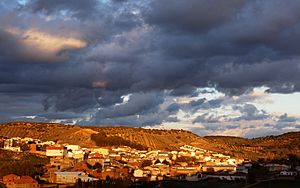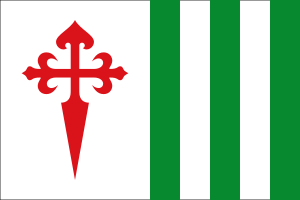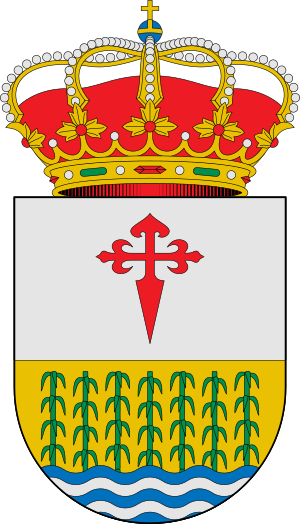Carrizosa facts for kids
Carrizosa is a small town in Spain. It is located in the province of Ciudad Real. This area is part of the Castilla-La Mancha region.
Contents
Carrizosa Through Time: A Brief History
Carrizosa has a long and interesting history. People have lived here for a very long time.
Early History and Important Battles
Long ago, during the Iron Age, special pots for burials were found here. These pots had painted stripes. After a big battle called Alarcos, the area was taken over by Muslims again.
In 1212, a major victory happened at Las Navas de Tolosa. This led to the Order of Santiago taking control of the Campo de Montiel region. They finished taking over the area in 1229.
Carrizosa Grows and Changes
In 1215, King Henry I of Castile gave Carrizosa to Count Don Alvaro Nunez de Lara. The king wanted new people to move there and help the town grow.
Later, in 1243, the Order of Santiago and the Alcaraz council had disagreements. They argued about who owned the castles and villages in Campo de Montiel, including Carrizosa.
By 1387, Carrizosa was given to Pedro Diaz de Monsalve. He was the first known leader of the area. At this time, about 90 people lived in Carrizosa. The old castle was left empty. People started to live in the town's current spot, near the Carrizosa River.
Building the Church and Facing Challenges
The parish church of Santa Catalina was finished in 1493. It had stone arches and a wooden roof. A cemetery was next to it.
By 1515, Carrizosa faced tough times. Bad harvests and sickness caused the population to drop to only 45 people. A painter named Hernando de Miranda finished a beautiful altarpiece for the church that year. Visitors from the Order of Santiago often came to check on the church and its treasures.
Becoming Independent and Modern Times
In 1590, Carrizosa became independent from Alhambra village. They paid a large sum of money for their freedom. The next year, the population grew to 75 people.
By 1787, Carrizosa was officially a town with its own mayor. The town had 349 residents. Most people worked as laborers or farmers.
During the time of Napoleon's invasion in 1811, there was a plan to bring water to the area. This plan would have helped mills and farms. However, the war stopped it from happening.
In 1900, Carrizosa had 1507 people. A smallpox sickness affected the town around 1920, causing many deaths. In 1925, a power plant was built at an old mill. The new church was completed in 1928.
In 1931, a group of women damaged the power station due to a political issue. The town lost power until the next year. A new cemetery was built in 1932.
Carrizosa reached its largest population in 1960 with 3026 residents. In 2012, a movie was filmed in Carrizosa. It was the last film for actress Sara Montiel.
A local writer and film director, Oscar Parra de Carrizosa, wrote a book about the town's history in 1992.
Fun Traditions and Local Customs
Festive and Food Traditions
Carrizosa has many special traditions, especially around holidays.
San Antón Celebrations
On January 17, people celebrate San Antón. Years ago, men on horseback would ride through the streets. They would try to catch cakes thrown from balconies. These cakes were similar to the San Blas rolls.
Another tradition was called "the fifths." On the night before January 17, young people would light big bonfires in the streets. The biggest fire was in the main square. People would gather around the fires to eat, drink, and dance to old songs.
An even older tradition was letting a pig roam the streets. Everyone in town would feed it. This is why there's an old saying in Carrizosa: "to be like the pig of San Antón," meaning someone who lives freely on the streets.
San Blas and Santa Águeda Rolls
On February 3 and 5, people celebrate San Blas and Santa Águeda. They make special crispy rolls from flour, water, oil, salt, and aniseed. These rolls are baked the day before Mass to be blessed. Families often share them as a religious promise or to thank the saints for good health.
Tostones: A Sweet Treat
Tostones are a type of nougat made at home on October 31. They are made by melting sugar and mixing it with almonds and walnuts. Sometimes peanuts are added too. The mixture is spread flat to cool. Making tostones is a fun way for families and friends to gather.
Christmas Morning Gatherings
On December 25, families and friends celebrate "Matins." This tradition usually happens after midnight Mass. It marks the end of the rule against eating meat on Christmas Eve.
Amazing Places to See
Historical Buildings and Natural Wonders
Carrizosa has beautiful buildings and natural spots.
Church of Santa Catalina
The Church of Santa Catalina has amazing paintings on its ceiling and altar. These paintings show Santa Catalina going to heaven. On the roof, you can see pictures of the four evangelists with their symbolic animals. Other paintings show the Last Supper and Jesus as a shepherd. These were painted by Jesus Velasco in 1942.
Source of Mina
The Source of Mina is an old public water source. It provided water for people and animals. Its age is unknown. It was also used to water gardens that were once below it. The monument has been repaired many times. Its name, La Mina, might come from how it collects water from the foot of a mountain.
Other Interesting Sites
- The House of the Commanders is in the main square.
- The "Via Crucis" Route has 14 crosses throughout the streets. These crosses are cared for by the local people. It's a great way to explore the oldest parts of the village and enjoy views from higher streets.
Hermitages and Ancient Ruins
Hermitage Virgen del Salido
This hermitage is at the bottom of Castellon hill. Near it are the ruins of the old Moorish castle of Peñaflor. The hermitage was rebuilt in 1968 after the Civil War.
Shrine of Our Lady of the Holm Oak
This shrine is about 1.5 miles from Carrizosa. It was one of Carrizosa's oldest hermitages. Even though it now belongs to the nearby town of Villahermosa, people in Carrizosa have always felt a strong connection to this ancient black virgin statue.
Archaeological Remains
You can find the old ruins of the Moorish castle of Peñaflor next to the Hermitage Virgen del Salido.
Historic Estates
- The House of Work and the Fuenlabrada farm were once owned by the Count of Leyva.
- The Palace of the Dukes of San Fernando de Sevilla is another important building.
Beautiful Landscapes
Exploring Carrizosa's Nature
Carrizosa is surrounded by lovely natural areas.
Huelma Caves
Near the old Huelma farm and mill, you can find the Huelma Caves.
Stream of the Toriles
The Stream of the Toriles has a waterfall that you can only see in rainy years. It's a wild area with caves, large rocks, and many small waterfalls and springs.
Azuer River
The Alameda Azuer River, also known as the Salido River, flows through the area.
Old Farmhouse Ruins
The ruins of the House of Oydor are an old farmhouse. They appeared on maps from 1765. They are located on the old road to La Solana.
Fuenlabrada Estate Roads
The roads and places within the Fuenlabrada estate offer scenic views.
Exciting Festivals
Annual Celebrations in Carrizosa
Carrizosa has many lively festivals throughout the year.
San Antón
San Antón is celebrated on January 17. It's traditional to light bonfires in the streets.
The May
"The May" is celebrated on April 30. It honors the Virgen del Salido.
May Crosses
The May Crosses festival takes place on May 2, 3, and 4.
San Isidro
San Isidro is celebrated on May 15.
Our Lady of Salido Celebrations
Festivities honoring Our Lady of Salido happen between August 13 and 16.
Pilgrimage of the Virgin
The Pilgrimage of the Virgin to the Chapel of the Departed is on the last weekend of August.
Hearts of Jesus
This is another traditional festival.
The most popular festivals in Carrizosa are the May Crosses and the party honoring the Virgen del Salido.
The May Crosses Festival
The May Crosses festival runs from April 30 to May 4. On the evening of April 30, young people walk through the village. They sing traditional songs called "Ladies Mays." On May 2, they sing to the "Crosses." These are altars decorated in people's homes. Treats are also shared.
This festival started as a pagan celebration of spring. It has changed over time but is still very traditional in Carrizosa. When it became a Christian holiday, it celebrated the Cross as a symbol of Jesus's suffering. People decorate crosses with flowers and plants, along with symbols like nails or the crown of thorns.
The celebration truly begins on the evening of April 30 and continues into the early morning of May 1. During this time, groups of young men and women sing songs to their loved ones. This is called "ladies night." They start with a traditional song called "in May." In this song, they describe the beauty of a woman.
The altars for Corpus Christi, celebrated in June, are also very interesting.
See also
 In Spanish: Carrizosa para niños
In Spanish: Carrizosa para niños




